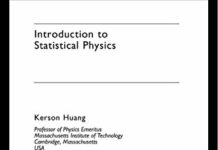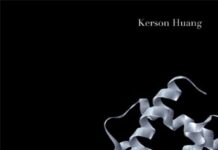
Ebook Info
- Published: 1991
- Number of pages: 493 pages
- Format: PDF
- File Size: 15.63 MB
- Authors: Kerson Huang
Description
Unlike most other texts on the subject, this clear, concise introduction to the theory of microscopic bodies treats the modern theory of critical phenomena. Provides up-to-date coverage of recent major advances, including a self-contained description of thermodynamics and the classical kinetic theory of gases, interesting applications such as superfluids and the quantum Hall effect, several current research applications, The last three chapters are devoted to the Landau-Wilson approach to critical phenomena. Many new problems and illustrations have been added to this edition.
User’s Reviews
Editorial Reviews: About the Author Kerson Huang is Professor of Physics at the Massachusetts Institute of Technology, Cambridge, USA, and a leading authority on quantum physics. He is a highly experienced textbook writer and has written Statistical Mechanics, also published by Wiley. Professor Huang?s research interests focus on Bose-Einstein condensates and non-renormalizable theories.
Reviews from Amazon users which were colected at the time this book was published on the website:
⭐I learned statistical mechanics from `Statistical Mechanics’ by K. Huang and `Statistical Mechanics’ by S.K. Ma. In my opinion, most books on the elementray principles, including the book by K. Huang, are too complicated for beginners. The best treatments as far as I know are given by `Statistical Physics, part I’ by Landau and Lifshize and the one by S.K. Ma. Another weak points in Huang’s book are the discussions about ideal quantum gases. It presents formal mathematical methods to study this problem. I think that this approach is also too complicated for beginners and sometimes bury the relevant physical ideas. In this part, the best treatment for the ideal Bose gas is given by `Statistical mechanics’ by T.D. Lee (in Chinese), and for the ideal Fermi gas given by S.K. Ma.For these parts, I should give 3 stars. However, the strong parts of Huang’s book is the chapters on the advanced topics. The writting is compact and clear. They can be served as a good introduction to the modern theory of critical phenomena and superfluidity. Further, they are useful references for research. In addition, the formal manipulation for quantum ideal gases is necessary for research though it seems a little bit complicated for students. For all these, I gave 4 stars to this book.Finally, I should say that the approach of Huang’s book is not based on the kinetic theory though it spends a few chapters on this aspect. The reason why the kinetic theory is put before the chapters on SM, in my opinion, is to emphasize the important role played by collisions between particles to establish thermal equilibrium and the validity of the basic assumption of SM, as indicated by S.K. Ma in his book. I think previous reviews about this are misleading.
⭐I just completed a class taught from Huang. It was rocky. If this is your first time through a serious stat mech class, you have difficulty with thermodynamics, or you are the sort of person that learns by doing, then this probably isn’t the book for you.That being said, if you have a strong background in stat mech and thermo, you’ll probably find Huang quite enlightening. Huang’s approach isn’t the most pedagogically sound, but he is more insightful than most. (In the sense of what he presents, not necessarily how he presents it.)Additionally, while there are errors in the book, there aren’t so many that it makes it unreadable — the book is hard to read based on its own construction.I managed to do well in the course, but it was by constantly referencing other books. If this is your first time through, I recommend reading the material of the current chapter in another book first, running a couple of example problems from that book, and then reading through Huang. It seemed to work better as a reference into usually uncovered topics than as a textbook. The first few chapters on thermodynamics and (non-quantum) statistical mechanics are probably best learned from another source.
⭐I love this book because it covers almost all the concept in graduate level Statistical Mechanics. I love this book very much.
⭐no problem EXCELLENT book
⭐In my 18 years of formal education, this is the worst textbook I have ever used in any subject. His writing style is awful, the book is littered with typos, his notation is completely different from any I’ve ever seen, and attempting the homework problems is similar to trying to write an essay in Korean with only a travel guidebook as a reference. Even the paper and cover is of substandard quality. If you are an instructor and are reading this, for the love of god, DON’T USE THIS FOR YOUR COURSE.
⭐It might or might not be a good idea to use this book as a textbook for a course of statistical mechanics. However, it contains some material which is difficult to find elsewhere. First of all, there is a very nice exposition of Lars Onsager’s own solution of the 2D Ising model which I found easy to follow. The book also contains a nice illustration of renormalization ideas with the 1D Ising model. The first edition of the book appeared in 1960-es and contained some new pedagogical ideas which appealed to many physicists. The book was almost immediately translated into Russian which emphasizes its significance.
⭐I am an undergraduate mathematics student and I have been assigned this book for a third year SM course. It’s not perfect, but I am really enjoying it and find the style terse yet clear, and fairly thorough (most of the questions which arise in my mind are covered in the text). There have been a few points where I didn’t get the proofs, but on the whole I have found it extremely useful (and much better than my lecturer). I really don’t get people’s problem with this book. Someone said that it lacks physical explanations. This is supposed to be an advanced mathematical theory. If you don’t appreciate rigorous proofs of conclusions and prefer handwaving and reams of empty text saying the same thing in 50 different ways then put this book down and go play in a sandpit.
⭐It is exactly what I expected!
Keywords
Free Download Statistical Mechanics, 2nd Edition 2nd Edition in PDF format
Statistical Mechanics, 2nd Edition 2nd Edition PDF Free Download
Download Statistical Mechanics, 2nd Edition 2nd Edition 1991 PDF Free
Statistical Mechanics, 2nd Edition 2nd Edition 1991 PDF Free Download
Download Statistical Mechanics, 2nd Edition 2nd Edition PDF
Free Download Ebook Statistical Mechanics, 2nd Edition 2nd Edition



